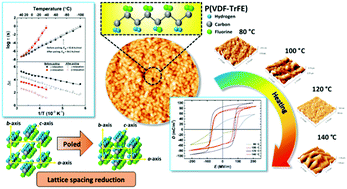Structural control of the dielectric, pyroelectric and ferroelectric properties of poly(vinylidene fluoride-co-trifluoroethylene) thin films†
Abstract
The effects of solvents and temperature on the crystal formation were investigated for vinylidene fluoride/trifluoroethylene copolymer P(VDF-TrFE). Highly crystalline P(VDF-TrFE) thin films were fabricated by spin-casting using various polar solvents such as diethyl carbonate (DEC), methyl ethyl ketone (MEK), N,N-dimethylformamide (DMF) and dimethyl sulfoxide (DMSO). Ferroelectric polarisation reversal of the P(VDF-TrFE) was evidenced by a displacement (D)–electric field (E) hysteresis loop measurement and supported by the presence of pyroelectric activity. The samples which were annealed above 100 °C gave elongated rod-like crystalline structures and the highest crystallinity, Xc of 83% was formed at 120 °C. Consequently, remnant polarisation (85 mC m−2) and the pyroelectric coefficient (30 μC m−2 K−1) were enhanced. Thus, annealing plays a substantial role in controlling the crystalline structure of P(VDF-TrFE) films regardless of the choice of solvent. Although, the crystalline structure control is almost independent of the solvent's polarity, the choice of solvent is essential in preparing a smoother film surface. Molecular dynamics of P(VDF-TrFE) are discussed from the observation of two dielectric relaxation processes, β and γ related to the segmental micro-Brownian and local modes, respectively. The complete ferroelectric polarization reversal caused a reduction in the dielectric polarization and reduced the lattice spacing of the 110/200 planes.



 Please wait while we load your content...
Please wait while we load your content...